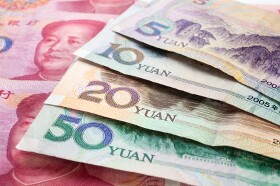The Chinese yuan is hitting the pause button on its recent acceleration against several major currency rivals midweek as many economic reports portray a grim picture of the worldâs second-largest economy. All the data came in worse than what the market had forecast, and with the coronavirus still lingering, experts warn there might be plenty more bearish news in the coming months.
The Caixin General Services purchasing managersâ index (PMI) crashed to an all-time low of 26.5 last month, down from 51.8 in January. Because of company closures and travel restrictions, new orders, exports, and employment levels cratered at the biggest rates ever documented. An important element of the data was the backlog of work orders that significantly spiked.
The Caixin General Composite PMI also cratered to 27.5 in February, down from 51.9 in January. Business confidence further slumped to a record low.
What may surprise analysts is the rail freight growth. According to China Railway, the state-owned railway operator, loaded 171,000 railway cars per day on average last month. This is an increase of just under 5,000 per day from the same time a year ago. Container freight soared 39.5% to 26.61 million tons. In the January-to-February period, freight cargo climbed 0.6% to an all-time high of 670 million tons. Why this is important is because analysts use the metric to determine the health of the economy.
Meanwhile, Assets Supervision and Administration Commission announced that several industries, including communications, utilities, transportation, and energy industries, have achieved an operation rate of 95%.
But China will not escape the wrath of Covid-19. Zhu Min, head of the National Financial Research Institute at Tsinghua University and former deputy managing director of the International Monetary Fund (IMF), estimates that the economy lost more than $200 billion in January and February due to the outbreak. He does believe, however, that online spending will likely offset some of the losses across multiple sectors.
The falling consumption in the first quarter could knock down growth by three or four percentage points. We need a strong rebound, and that needs 10 times as much effort.
Overall, Pacific Investment Management Co. (PIMCO) projects that the economic fallout from the virus may have caused a 6% contraction in the first-quarter gross domestic product.
After the Federal Reserve slashed interest rates by 50 basis points on Tuesday, many had expected the People’s Bank of China (PBoC) would follow suit. However, Beijing left short-term borrowing costs steady and kept repurchase agreements unchanged.
The USD/CNY currency pair edged up 0.07% to 6.9671, from an opening of 6.9621, at 13:12 GMT on Wednesday. The EUR/CNY tumbled 0.41% to 7.7408, from an opening of 7.7882.
If you have any questions, comments, or opinions regarding the Chinese Yuan, feel free to post them using the commentary form below.
